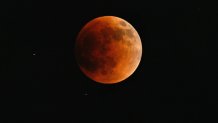A total lunar eclipse graced the night skies over the weekend, providing longer than usual thrills for stargazers across North and South America.
The celestial action unfolded Sunday night into early Monday morning, with the moon bathed in the reflected red and orange hues of Earth’s sunsets and sunrises for about 1 1/2 hours, one of the longest totalities of the decade. It was also the first so-called blood moon in a year.
Observers in the eastern half of North America and all of Central and South America had prime seats for the whole show, weather permitting. Partial stages of the eclipse were visible across Africa, Europe and the Middle East. Left out: Alaska, Asia and Australia.
NASA provided a livestream of the eclipse from various locations.
Get Boston local news, weather forecasts, lifestyle and entertainment stories to your inbox. Sign up for NBC Boston’s newsletters.
A total eclipse occurs when Earth passes directly between the moon and the sun, and casts a shadow on our constant, cosmic companion. The moon was 225,000 miles away at the peak of the eclipse — around midnight on the U.S. East Coast.
There’ll be another lengthy total lunar eclipse in November, with Africa and Europe lucking out again, but not the Americas. Then the next one isn’t until 2024.
Scroll down to see photos of the "blood moon" total lunar eclipse:




